#1900s petticoat
Text
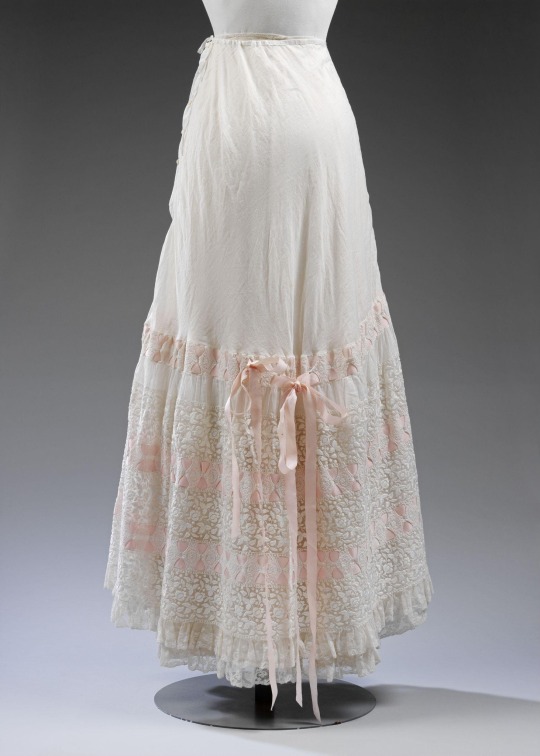
White Cotton Petticoat, ca. 1906, English.
Worn by Miss Heather Firbank.
Victoria and Albert Museum.
#V&A#1906#1900s#1900s petticoat#petticoat#1900s England#1900s Britain#cotton#womenswear#extant garments#1900s extant garment#English#British#20th century#Heather Firbank#undergarments#1900s undergarment
235 notes
·
View notes
Photo
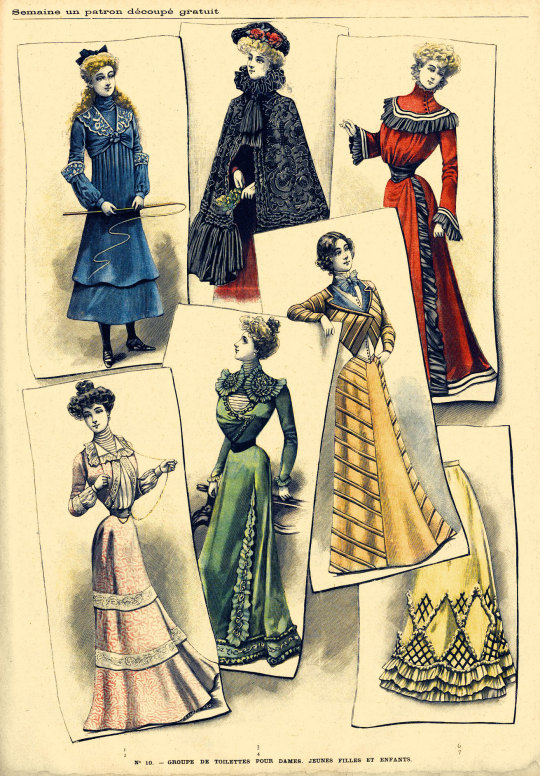
La Mode nationale, no. 18, 4 mai 1901, Paris. No. 10. — Groupe de toilettes pour dames, jeunes filles et enfants. Bibliothèque nationale de France
Explications des gravures:
(1) Robe de promenade pour fillettes de 10 à 11 ans, en lainage fantaisie bleu-saphir. Robe façon Empire, sur une seconde jupe en forme. La robe est plissée à la taille; petit boléro drapé, fixé sous un chou; col revers appliqué de guipure blanche; col drapé en taffetas bleu. Manches à revers augereau, brodé; bouffant de taffetas bleu froncé dans un poignet droit.
Matériaux: 4 mètres de lainage; 2 mètres de taffetas.
(1) Walking dress for girls aged 10 to 11, in fancy blue-sapphire wool. Empire style dress, on a second shaped skirt. The dress is pleated at the waist; small draped bolero, fixed under a cabbage; lapel collar applied with white guipure; draped collar in blue taffeta. Augereau cuffed sleeves, embroidered; puff of blue taffeta gathered in a right wrist.
Materials: 4 meters of wool; 2 meters of taffeta.
—
(2) Robe de five o'clock pour jeune femme ou jeune fille, en foulard blanc à ramages rose pâle. Jupe en forme, collante des hanches, guipure blanche. Boléro arrondi bordé de guipure. Col revers de batiste entouré d'un volant plissé; Chemisette en liberty blanc plissé; bouffant de manches froncé dans un poignet droit.
Matériaux: 10 mètres de foulard; 2 mètres de liberty.
(2) Five o'clock dress for a young woman or girl, in white scarf with pale pink branches. Shaped skirt, tight hips, white guipure. Rounded bolero trimmed with guipure. Cambric lapel collar surrounded by a pleated ruffle; Pleated white Liberty shirt; puff sleeves gathered in a right wrist.
Materials: 10 meters of scarf; 2 meters of liberty.
—
(3) Manteau élégant pour dame d'un certain âge; fleurs de Chantilly découpées, rebrodées en relief et appliquées sur du gros tulle. Volant de mousseline de soie noire surmonté de bouillonnés en mousseline de soie. Au col, ruche terminée par des pans faisant rabat.
Matériaux: 5 mètres de tulle; dentelle en laize pour découper; 10 mètres de mousseline de soie.
Chapeau de crin noir fleuri de roses.
(3) Elegant coat for a lady of a certain age; Chantilly flowers cut out, re-embroidered in relief and applied to heavy tulle. Black silk muslin ruffle topped with swirls of silk muslin. At the collar, a ruche ending in sections forming a flap.
Materials: 5 yards of tulle; wide lace for cutting; 10 yards of chiffon.
Black horsehair hat flowered with roses.
—
(4) Robe en homespun oyster. Jupe ample du bas bordée de deux bouillonnés de taffetas vert même ton entre lesquels court une broderie pailletée acier. Quille de taffetas froncillé fixée par une broderie. Corsage drapé bordé de broderie, décolleté sur un plastron plissé à plis lingerie en taffetas blanc. Col en taffetas brodé entoure de petits plissés. Manche mitaine à petit volant de taffetas.
Matériaux: 6 mètres d'homespun; 3 mètres de taffetas.
(4) Dress in homespun oyster. Full skirt at the bottom lined with two bubbles of green taffeta of the same tone between which runs a steel sequined embroidery. Ruched taffeta quille fixed with embroidery. Draped bodice edged with embroidery, neckline on a pleated plastron with lingerie pleats in white taffeta. Embroidered taffeta collar surrounded by small pleats. Mitten sleeve with small taffeta flounce.
Materials: 6 yards of homespun; 3 meters of taffeta.
—
(5) Robe de promenade pour jeune femme ou jeune fille, en granité havane clair. Jupe rayée de biais en travers, devant uni; Boléro croisé, rayé de biais; gilet de taffetas blanc piqué noir et fermé par de très petits boutons. Col revers en taffetas bleu ou panne ou velours léger. Cravate en mousseline de soie bleue. Manches rayées de biais.
Matériaux: 7 mètres de granité; 0m,50 de taffetas bleu; 1 mètre de taffetas blanc.
(5) Walking dress for a young woman or girl, in light Havana granite. Striped skirt across, plain front; Bolero crossed, striped on the bias; vest in white taffeta with black stitching and fastened with very small buttons. Lapel collar in blue or panne taffeta or light velvet. Blue Chiffon Tie. Bias striped sleeves.
Materials: 7 meters of granite; 0m.50 of blue taffeta; 1 meter of white taffeta.
—
(6) Robe de réception pour jeune femme ou dame d'âge moyen, en crépon geranium. Jupe drapée, bordée de biais de taffetas blanc avec dépassant noir et ouverte de côté. L'ouverture est ornée d'un plissé en mousseline de soie. Corsage blouse rentré sous une ceinture corselet en satin noir. Grand col faisant empiècement, bordé de biais blancs et d'un volant plissé en mousseline de soie noire. Manche élargie du bas, garnie comme l'empiècement.
Matériaux: 12 mètres de crêpe; 4 mètres de taffetas blanc; 6 mètres de mousseline de soie; 1 mètre de taffetas noir pour les dépassants.
(6) Reception dress for a young woman or middle-aged lady, in geranium crepon. Draped skirt, bordered on the bias in white taffeta with black overhanging and open on the side. The opening is decorated with a silk chiffon pleat. Blouse bodice tucked under a black satin corselet belt. Large yoke-shaped collar, edged with white bias and a pleated flounce in black silk muslin. Sleeve widened at the bottom, trimmed like the yoke.
Materials: 12 meters of crepe; 4 meters of white taffeta; 6 meters of chiffon; 1 meter of black taffeta for the overhangs.
—
(7) Jupon de costume, en taffetas soufre. Au bas, trois volants en mousseline de soie or, surmontés d'un bouillonné; au-dessous, dents aiguës dessinées par des bouillonnés posés pied contre pied, et remplies par des croisillons en comètes de velours noir.
Matériaux: 6 mètres de taffetas; 6 mètres de mousseline de soie.
(7) Suit petticoat, in sulfur taffeta. At the bottom, three ruffles in gold silk muslin, topped with a swirl; below, sharp teeth drawn by swirls laid foot to foot, and filled with lattices like comets of black velvet.
Materials: 6 yards of taffeta; 6 yards of chiffon.
#La Mode nationale#20th century#1900s#1901#periodical#fashion#fashion plate#color#description#Bibliothèque nationale de France#dress#cape#suit#collar#petticoat
84 notes
·
View notes
Text
1908 Petticoat by ? (location ?). From lamodedelabelleepoque.tumblr.com/post/87617167489.
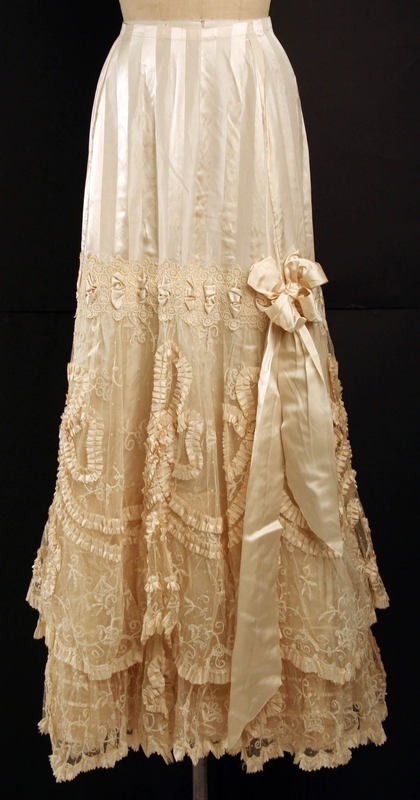
#1908 fashion#1900s fashion#Belle Époque fashion#Edwardian fashion#petticoat#natural waistline#lace#flounces
13 notes
·
View notes
Photo

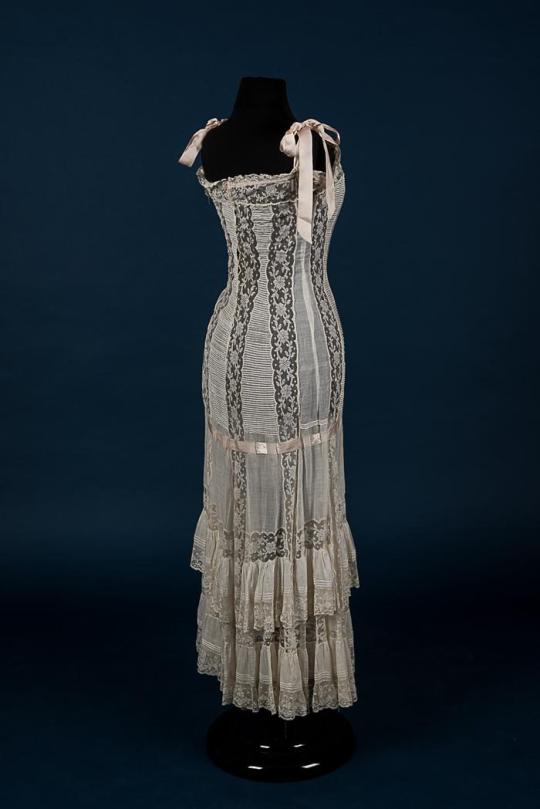

Petticoat (w/lace inserts), c.1900
43 notes
·
View notes
Text
Travels with Jonathan Harker, in pictures
If our good friend Jonathan Harker had sent us some photos along with his lovely email, here's what he might have included. All photos are as close to contemporary as I could find.
Left Munich at 8:35 P. M.:

arriving at Vienna early next morning:
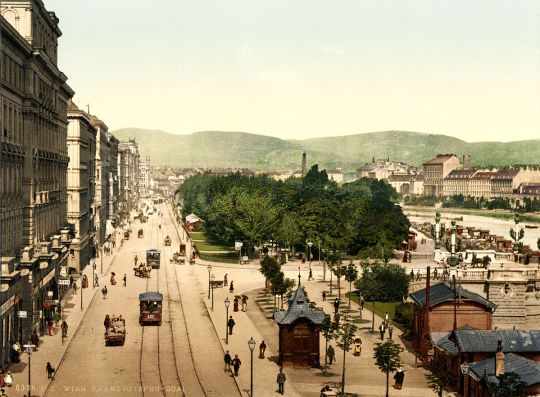
Buda-Pesth seems a wonderful place, from the glimpse which I got of it from the train and the little I could walk through the streets:
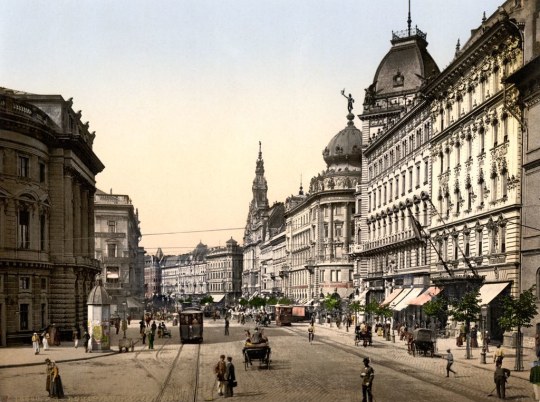
We left in pretty good time, and came after nightfall to Klausenburgh:

All day long we seemed to dawdle through a country which was full of beauty of every kind. Sometimes we saw little towns or castles on the top of steep hills such as we see in old missals:

sometimes we ran by rivers and streams which seemed from the wide stony margin on each side of them to be subject to great floods:

The women looked pretty, except when you got near them, but they were very clumsy about the waist. They had all full white sleeves of some kind or other, and most of them had big belts with a lot of strips of something fluttering from them like the dresses in a ballet, but of course there were petticoats under them:
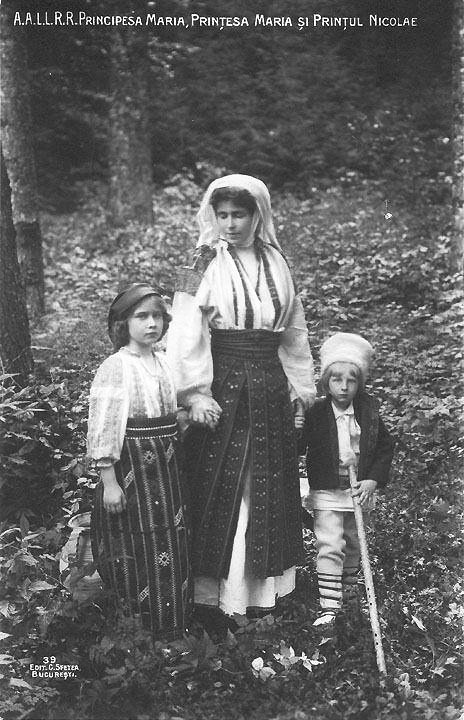

(on the left: the Romanian royal family in peasant cosplay in the early 1900s; on the right, a photoshoot of Romanian national dress in 1868)
It was on the dark side of twilight when we got to Bistritz, which is a very interesting old place:
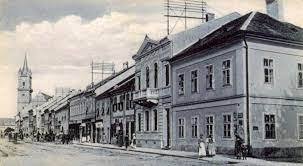
Bonus: a postcard Jonathan might have picked up for Mina.

7K notes
·
View notes
Photo
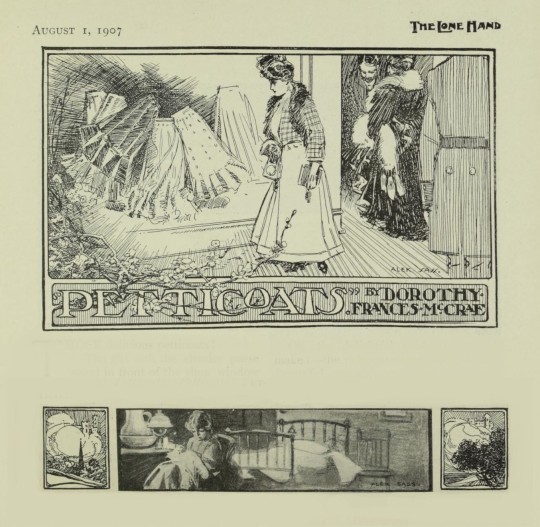
Alec Sass - Petticoats, The Lone Hand, Vol. 1 No. 4, 1st August, 1907
#Alec Sass#Alexander Willams#Australian illustrator#magazine illustration#petticoat#narrative illustration#vintage illustration#illustration#1900s#1907
1 note
·
View note
Text
☆Update 2:☆
I remembered to take pics today! Sort of. Only after i had put away my machines and stuff...
Here are (most) of my edwardian undergarments
(i am wearing modern clothes under bcs the internet is weird)
Chemise, bustle pad, underbust corset, petticoat
I still need to make a corset cover someday, ive just been using a second thin chemise over all this:
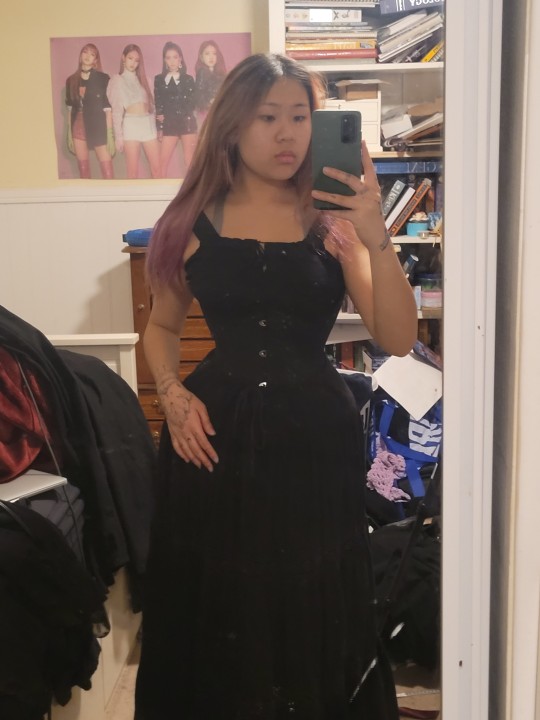
I used these vintage buttons on the cuffs. I wanted some more security but ran out of buttons so i used small snaps:
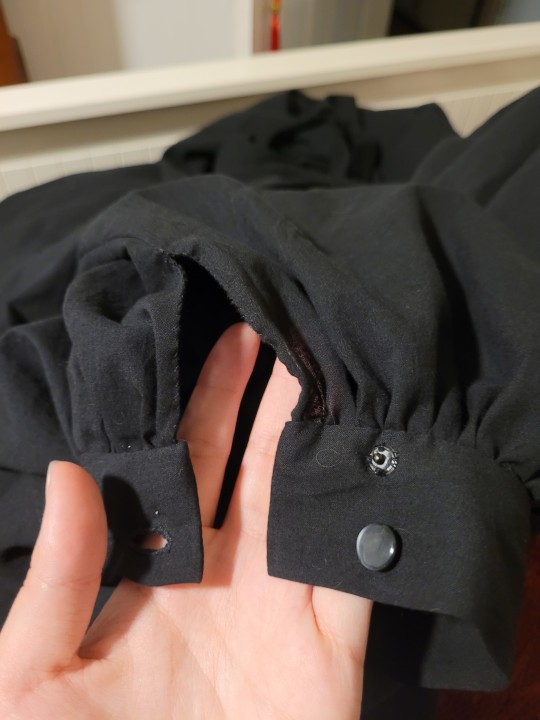
Also put one on the collar so i could try it on. I think the placket at the back of the blouse is a little ugly and larger than ive seen in extant garments but i forgot to adjust the pattern for my broad shoulders and need the extra width for comfort.

I tried on the blouse and skirt together:

I may need to loosen the waistband of the skirt, the corset is a bit bulkier than i thought itd be. Also the blouse is just stuffed into the skirt and currently only has one closure on at the collar so it looks a little bit disproportionate. The belt/sash will help smooth everything out so i dont look like im drowning in voile.
I might go without the bustle pad during the final shoot because i think it gives too much volume in the waist/hip area for edwardian tastes. Its from an 1890s pattern, so the silhouette is a bit out of date. I should probably try the skirt on without the pad before extending the waistband though.
Im pretty happy with how the sleeves turned out! I have some vintage nottingham lace i bought on etsy from penelope textiles that i was going to add to another project. I think ill sew some different laces together and add it to the cuffs to elongate them a bit. Since this dress is supposed to be from roughly 1905, i want the sleeves to look as they wouldve in that time. The photos ive seen mostly feature large ruffles at the ends of elbow-length sleeves but i dont think ill be likely to wear ruffles very often. Ive also seen tighter cuffs that extend from the elbow to mid-forearm or from the elbow to wrist. I think the elbow-length sleeves are a feature of afternoon dresses but i could be wrong. Maybe that was just day dresses? Not sure.
Im also not sure if i want to get gloves/a hat/parasol for this project. On one hand, it would look really cool for the video. On the other hand, it sounds quite expensive and i doubt ill wear it again. I dont want to buy things i wont use and create waste, theres enough of that in fashion. I have a pink 1900s parasol that i might cover with black fabric, but idk.
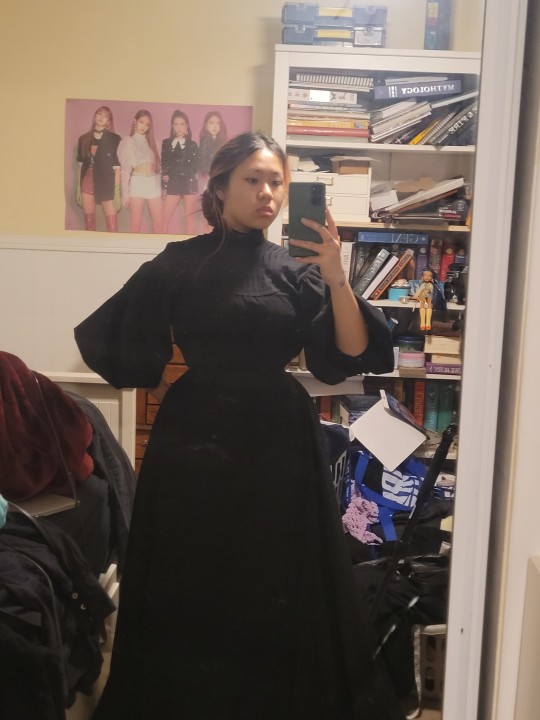
There isnt much left to do! Im gonna make a list here so i have it written somewhere:
-sew snaps onto blouse
-finish blouse hem
-attatch lace cuffs
-press pleats on sash/belt
-order synthetic whalebones
-add bones, hook/bars to belt
This is just the sewing tasks though, i need to edit the video clips and record audio. I have no idea how to do any of this. I just downloaded davinci video editor so hopefully i can figure it out. The only experience i have with video making/editing was in 3rd grade on ipads on the imovie app. Ive just been binge watching bernadette banner videos bcs i love her video style.
Any tips/feedback are much appreciated! ♡
Date: 4/22/24
#edwardian fashion#1900s#early 1900s#edwardian era#edwardian#victorian mourning#victorian dress#victorian era#victorian fashion#fashion history#historical costuming#historical dress#historical fashion
65 notes
·
View notes
Note
I'm new to the historical costuming and historybounding community and I noticed something odd and I wnated to know your opinion about it.
1850s/60s clothes are essentially nonexistent in the community at large. Every now and again, someone will make a Little Women inspired something, but that's it. No one seems to dislike this period, but no one seems to love it either?
Which confuses me so much because I would have assumed it to be one of the most popular styles, the way that the 1890s are in actuality.
Oh yeah, you're absolutely right! It IS rather underrepresented.
My main thought is that it's less practical for potential everyday modern wear than the later 19th century, and therefore less popular. Hoop skirts are marvelous, and not as huge or unwieldy as people like to think, but they're still not terribly practical for most people's lives nowadays. I adore the late 60s/early 70s elliptical skirt and bustle styles, but taking up so much space on the train would get me intense dirty looks at minimum. So I tend to aim a bit later- Natural Form or 1880s/90s transitional.
(Though I admit, it IS rather frustrating that almost every other daily wear historical costumer does 1890s/early 1900s. I want tips for styling a blouse so it looks less Edwardian Shirtwaist and more 1879 Blouse Waist, damnit! I can look at ads and photos and extant garments and fashion plates myself, but I'd love to have living people to compare notes with.)
I can recommend two bloggers who do more 1860s stuff, though: The Quintessential Clothes-Pen (Quinn Burgess) and Plaid Petticoats (Raven Stern). They do other eras as well, but it's not as much of an 1890s washout as popular costubers sometimes tend to be- with no hate intended to those people; that's just what they like to make! Neither of the bloggers I recommended are Everyday Victorian Clothing people, so that might contribute to their era flexibility.
Best of luck in finding your 1860s dream content!
(Also, if you DO want some more practical everyday 1860s, you could try looking at 1867-69; there was a brief A-line skirt moment there that everyone forgets about, but which would be less space-consuming than hoops.)
122 notes
·
View notes
Text
The Evolution of Pants for Women: from Underwear to Fashion Statement, Part I
I've posted a lot on the Victorian fashion era which, frankly, is favorite – visually, anyway. It's time to jump ahead a bit to the 1920's and catch a glimpse of how rapidly fashion changed in the late 1900s to 1920s.

figure 1
First, a quick run-down of how underpants led to actual fashionable dress. In the better part of the 19th century, women had no need of underpants because of the many layers they donned as part of their dress ritual. During the Regency period, some women, not yet incumbered by hoops and bustles, would sometimes wear male-style underpants if they couldn't resist a dress made from a sheer fabric. It meant less need for extra petticoats as well as a guarantee that nothing private would be exposed in dubious, uncontrolled light.
Usher in the Victorian era and hoop skirts and petticoats were sufficient to satisfy modesty.
In the early 1900s we begin to see the emergence of pantaloon-chemise combos, slips, and various types of corsets that are beginning to look more like the modern girdle. (Figure 2)
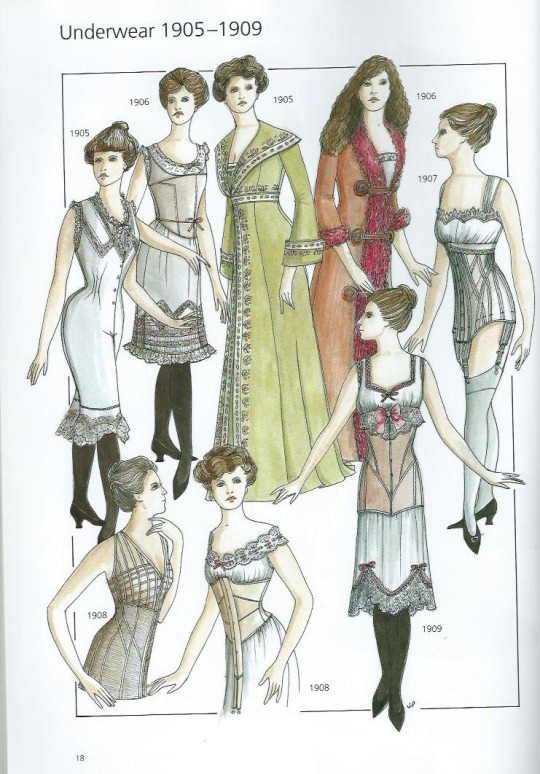
figure 2
The first woman in history to wear trousers was Elizabeth Smith Miller, known as Libby, in 1851. The popularity of the ‘pantaloon’ style, however, was due to Amelia Jenks Bloomer, an American women’s rights advocate and publisher of the magazine, The Lily. Through the magazine, Amelia helped to popularise ‘bloomers’ in the late 1850s, and hence, the bloomer style was consequently named after her.
“As soon as it became known that I was wearing the new dress, letters came pouring in upon me by hundreds from women all over the country. They were making inquiries about the dress and asking for patterns. It showed how ready and anxious women were, to throw off the burden of long, heavy skirts,” Amelia Jenks Bloomer wrote at that time. Shortly after, the style started to gain a lot of media recognition. The newspapers of those days described the style as: “Pantaloons" or ‘Turkish trousers" – "men-garments designed specifically for women.”

figure 3
Amelia suggested to women to wear less tight clothing and more comfortable clothing – women's trousers – a very radical idea for the times. They were very wide trousers, narrow at the ankle, with a short skirt on top. The idea was then revived in 1881 by viscountess Haberton, who founded The Rational Dress Society in England, a movement that replaced the use of women's dresses in the name of health and hygiene, proposing the use of wide trousers or pant-skirts. (Figure 3)
Women in pants were intimidated, harassed, and ridiculed to the point that, by 1859, even the most daring, including Jenkins Bloomer, gave up their fight for pants.

1890's cigar-box lid depicting a satirical scene of women in pants and smoking cigars.
That, however, is obviously not the end of it. Stay tuned for part 2.
Sources:
Fashion History Timeline
messynecychick.com
scuola le leonardohttps
Ethnologia Europaea
History Extra
#fashion history#the history of bloomers#women's fashion history#history of pants for women#early women's rights#19th century fashion history#the resplendent outfit blog#history of underwear#victorian fashion history
22 notes
·
View notes
Note
hello! i am a longtime huge admirer of your clothing/fashion sense, as well as a longtime backreader of your #victorian and #goth tags. i am really interested in what you've written about Victorian dress, and i am looking to get more into 19th and 20th century clothing for gender + diy craft reasons. i'm so sorry if you've answered similar questions before, but do you have any tips for where a newbie should start researching? either way, thank you thank you, your blog opens my mind wide and brings me much joy and reflection!
General research:
Spend some time searching the 'net, museum websites, and archive sites for fashion plates (such as archive.org—link leads to a date-restricted query for "fashion"—or the Smithsonian—link leads to fashion plates in their image collection). Take note of what you like, as well as which styles correspond to which decade. Karolina Żebrowska has a good rundown of English fashion over the decades.
The undergarments are what does the most work creating the necessary silhouette to make Victorian & Edwardian womenswear fit properly. If you've figured out a decade you want your outfit to draw on, doing a quick search for "[decade] undergarments" should bring up plenty of blog posts, which may or may not cite primary sources (such is the fickle nature of the historical blogosphere). Bustle pads and sleeve supports can be purchased or made; they're both pretty simple, and tutorials abound.
Purchasing clothing:
Reproduction made-to-measure clothing can be readily found on etsy, but can be in the several-hundred USD range. I've had some luck finding vintage reproduction clothing (like, a skirt someone made by hand in the 1980s to a 1900s walking skirt pattern), which tends to be much cheaper.
Men, women, and children wore stays and corsets. As far as I know, Orchard Corset has the cheapest OTR corsets that are good quality and safe to wear. If you get a corset in the style of a specific decade handmade or made to measure, make sure that the seller tells you what the boning material is, what construction the boning is (spiral steel is sturdiest and most flexible), how many bones there are, what the corset material is, &c.—otherwise it's an indication of an unserious maker. Follow general advice for wearing corsets at a waist reduction (lace up slowly, break it in, &c.).
Antique Menswear on youtube gives a lot of good, practical advice for wearing late 19th-century and early 20th-century men's clothing (including where to buy reproductions and how to treat them, how to modify modern shirts to 19th-century standards with basically no sewing skills, &c.).
Actual antique clothing can be found and purchased online or at estate sales—usually in very small sizes, but I've seen Edwardian skirts and petticoats in an XL (also a small size, but...). You can also just simply browse this kind of thing for inspiration and save photos of anything you think you'd like to recreate.
Even clothing that was not "meant" to be worn by re-enactors can be clearly historically influenced (e.g. the huge boom in Victorian- and Edwardian- style blouses in the 1980s), so keep an open mind when shopping for vintage clothing! A lot of 1970s dresses that look "hippy" on their own can look very Victorian with the right undergarments and an updo. A lot of 1980s men's trousers also approach the right silhouette for the 1910s-inspired three-piece suit I'm trying to put together. Witness also the recent trend for big puffed sleeves!
Making or modifying clothing:
Victorian and Edwardian manuals for garment drafting and sewing can be found online—go to archive.org and search for "sewing," "drafting," or "dressmaking," then use the filters on the left to chuse which year(s) you want to see results from. Most of these have patterns that are sort of vibes-based: The work-woman's guide is one manual that claims to have patterns laid out strictly according to a grid.
I don't sew garments, but if Victorian pattern-writing for sewing is anything like it is for knitting, that may not be super useful. People do sell updates and graded 'translations' of antique patterns (which tend to be written in only one size) on etsy and ebay—just make sure from the description that it's 'deciphered' and translated rather than a scan of the original pattern!
One of the easiest things that you can do to add some Victorian or Goth flair to an otherwise plain-looking garment is to add trim. You can knit, crochet, or tat your own trim from Victorian lace-making patterns; purchase antique trim from resale sites; or buy braided or lace trim very cheaply at any craft store. Trim doesn't just have to go around the hems and cuffs of a garment: lace "insertions" between two pieces of fabric, as well as raised geometric patterns over the surface of a garment, are common in 19th-century clothing.

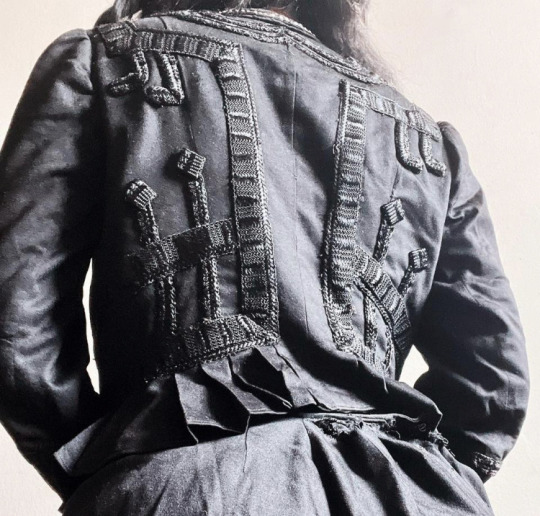
[ID: first image shows a black overdress showing lace insertions between strips of fabric of equal width, creating a striped effect. second image is the back of a black blouse with trim in a geometric design centred around right angles and parallel lines. end ID]
Jewellery (women's and men's):
Actual antique jewellery (including men's jewellery and fastenings) is not as expensive as you might think. Even if you're not willing to spend a lot of time learning what to look for and scouring estate sales for people who don't know or care what they have, late Victorian mass-manufactured costume jewellery often goes for sub-$50 or even $30 prices at auction on ebay (USD, in the US—in my experience it is even more plentiful and cheaper in the UK).
Specifically, I've lucked out with lots ("lot" as in, a bunch of small things being sold together) of "vintage men's accessories" going for $20 or so that contained Victorian cufflinks (in low-karat gold, mother-of-pearl, and jet), collar studs (in low-karat gold and base metals), and shirt studs (in low-karat gold, with garnets and seed pearls, &c.). Searching for lots of accessories is generally a good idea since by and large people do not know what these things are... but if you're willing to spend a little more for something that has been identified and is more likely to still be with its set, use the specific search term for that item (e.g. "antique collar studs").
Answers to Questions About Old Jewelry (though aimed at estate sellers and, if memory serves, full of regrettable pæans to Queen Victoria) is a good reference text to dating antique jewellery. I also recommend Miller's Illustrated Guide to Jewelry Appraising. Both of these texts are available on libgen.
Feel free to ask me follow-up questions if you want more detail on any of these points. As you can see I am perfectly happy to blather away on this topic
83 notes
·
View notes
Text
The funniest thing about loving historical fashion is some people just, genuinely don't understand it
There are people who don't know Crinoline cages were a thing and just genuinely think you layered petticoats until your skirts were that fluffy
There are people who don't know about lobster tails or Edwardian padding and think women were just forced into horrible posture.
Some people genuinely think stays just crushed your ribs and pelvis to give that cone body shape
People will unironically share pictures of anti-corset pamphlets from the early 1900s, where it shows corsets forcing your organs into your pelvis, and act like it's a medical diagram
43 notes
·
View notes
Text



White Cotton Petticoat, ca. 1905, English.
Victoria and Albert Museum.
#petticoat#1900s petticoat#1905#1900s#1900s England#1900s Britain#British#English#cotton#white#V&A#extant garments#womenswear#1900s undergarment#1900s extant garment#undergarments
141 notes
·
View notes
Photo

Le Petit écho de la mode, no. 7, vol. 23, 17 février 1901, Paris. Patron découpé offert gratuitement. Jupon habillé. Ville de Paris / Bibliothèque Forney
#Le Petit écho de la mode#20th century#1900s#1901#periodical#fashion#fashion plate#retouch#découpé#Forney#dress#corset#chemise#petticoat
68 notes
·
View notes
Text
I know many people hate Henry Wotton for being a huge misogynist, but I don’t think they understand that Victorian England was just like that. Because Victorian Society was all about rules, women and men were considered to be of different spheres that never overlapped. Henry, being a lord and thus a member of the upper class, saying “Women are a decorative sex” is less of an insult to women and more of an accurate statement about the roles of the women he’d mostly be around.
This was just how upper class women were viewed and treated in that time period. In every way, these women (because Victorian Society wanted all women to be like the Queen) were not meant to do much, but change into proper dress when appropriate, host parties and guests, and be on their husband’s arm when they went out. (see 'The Angel in the House' for more info)
Upper class women were literally not dressed to function. Assuming TPODG takes place during the 1880s (it was published in the early 1890s, the society it reflects is probably the 1880s), then they were wearing cuirass corsets, bustles, and pretty heavy petticoats. (this is not a demonization of any of those things—they are all cool on their own, but all three everyday for some odd ten or so years would eventually wreck your body.) These extreme gender roles would not be challenged until World War 1, when women’s roles were expanded in the war because an entire generation of mostly European men died.
Henry Wotton is a bastard man and this is not a post to get you to like him nor to defend the character (he’s fictional, put him in a blender for all I care), but it is to warn against using modern understanding and sensibilities when reading classics. “Decorative sex” is unfortunately what Victorian women were historically seen as—hell, our current modern understanding of women as their own persons and independent force has only existed since ~1900 (thank you, suffragettes). His treatment of women really isn’t any more misogynistic than most men of the time period—he’s a misogynist because most Victorian men (especially upper class) were misogynists.
#so fashion history is going well :)#tpodg#henry wotton#i think we have a tendency as modern day people to knee jerk away from things we disagree which is fair#but i think a lot of understanding about the character of henry wotton comes from the fact we struggle to see the true victorian period---#---and not the hollywood/glorified version.#or somethingidk#tbh i just got out of work and class so my thoughts are decently scattered#but this is something that's been on my mind for a while#I have more opinions about henry and victoria but those are long long longggggg and have to do with the modern reimaging au
20 notes
·
View notes
Photo
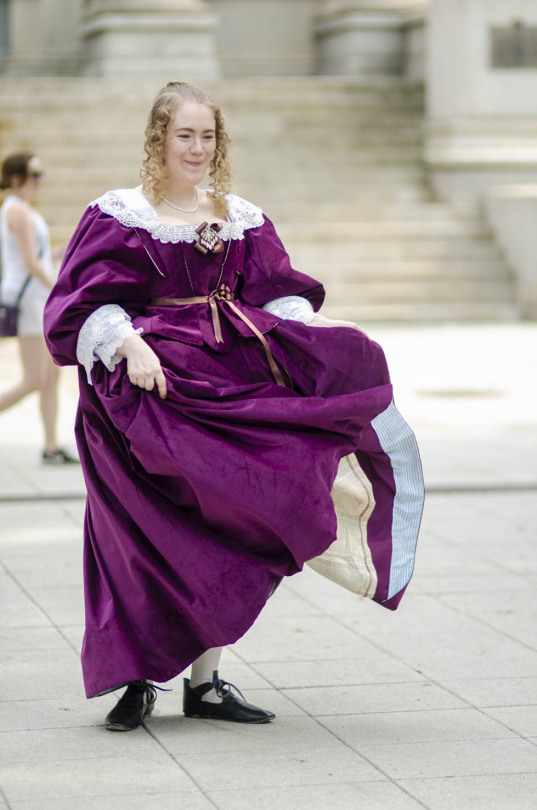

out of all the eras I’ve made (which is now 1530s, 1580s, 1630s, 1660s, 1770s, 1780s, 1790s, 1800s, 1820s, 1830s, 1860s, 70s, 80s, 90s, 1900s, 1910s, 1920s) - the 1630s is the only one I don’t think I could wear every day.
There’s just so MUCH up top! and the sleeves, despite being enormous, actually restrict your movement quite a bit because of the way they’re attached. I also dislike having to finagle all the cloth and skirts when it comes to putting on a bumroll, two petticoats, and THEN having to hoist yon bust up into a supportive bodice whilst constraining it under the shift. (Which honestly was an issue with 1660s too... There’s something to be said for separate bodies/stays.)
I was able to move around pretty well - stuffed myself into two Ubers without a problem, re-tied my shoes, etc. as you can see - but it just feels like a lot. I’m not sure the easy ability to bend at the waist is worth it 😂
#kenna talks#like i think you'd get USED to it#but it's a lot.1830s is kind of the same#but bc it goes on over corset and the bodice is less of a piece of armor....#less finicky#1630s#historical costuming#historical fashion#big lols#this IS fun to wear though so i'd like to pull it out again in the winter when i won't die of heatstroke#oops i forgot some decades
188 notes
·
View notes
Text
The Kate Sharmas in Real Life : Indian women in 19th Century Attire
As an Austenite, I find Bridgerton an abomination, from the costume to plotline. However, like many people I found the 2nd season a bit tolerable especially the storytelling. Simone Ashley who was Kate Sharma (it’s rather pronounced as “sher-ma”) reminded me someone, especially someone dressed in western clothes in colonial India.
It is a preconceived notion by many that Indian people, especially women did not wore western clothes until it was post 1960s, but it is not true. The most fundamental garment, a blouse for saree was a Victorian addition. The eastern Indian women often worn saree as a single garment, and in ancient times, Saree or “akhanda vastra” (undivided cloth) was worn with a “kanchuki” underneath, or an Indian version of Bandeau. Blouse, in its modern form was then called a Chemise (semij, as the local vernacular called it). It came as in late 19th century, and the trendsetters were Upper class Bengali women. Rabindranath Tagore mentions how modern yet scandalising it was for a woman to wear a “Semij” in his numerous novels, especially in Chokher Bali .The picture below is of Princess Sudhira of Cooch Behar wearing what can be deemed as the earliest Indo-Western Fusion fashion in 1900s (she was known to have some good european wardrobe)

You might be thinking, Indo-Western garment is not anything near to the empire line Regency costume! yes, it is not. But before you at me, behold this historical photograph.

She is Maharani Suniti Devi, Queen of the Princely state of Cooch Behar, North Bengal. This shot was taken at 1902. I Know I am 100 years too late but during the 1813 Indian royals were busy from saving their states from the British Subsidiary Alliances, and Artisans were getting crushed by the flooding capitalists as the Monopoly of the East Indian Company was abolished by the 1813 Charter Act--- long story short, they didn’t wear the western garments that early. I picked her photo specifically because Simone Ashley, as Kate Sharma reminded me of her. Tall, slim, thin mouth, bright eyes, voluminous hair and dark skin.
It is not that there are no dark skin rulers in India, and there were no royal women who donned western clothes--there are: in Fact the Daughter of Daleep Singh, the last Sikh Emperor and the Maharani of Kapurthala, both were photographed in Late Edwardian costumes in the beginning of 20th century. My pick is specially Suniti Devi because she exudes a classic ethnic Bengali beauty. I am emphasising on the fact Bengali because in Indian pop-culture Bengali women are portrayed as docile soft shy beings venerated for their big eyes and pliant beauty. However here you can see that this women is anything but. She is properly clothed in Late Victorian gown. From the prim contours of the waist it is clear that she is wearing proper undergarments like longline corset; light bustle as it was fashionable at that time and the correct petticoat. Loose but well arranged Gibson curls define her thick Bengali waves at the front of the head. The entire thing does not come off as costume-like, she looks like she was made for wearing it: she was not obviously corset trained because Indians often prefer loose fitted clothing and yet she does not look least bit out of place in that dress.
Despite everything western in that dress from the Gibson hair to the black passmentary lace detaiiing on the white skirt, there is a distinct Indianness that graces the outfit. A long trail of English tulle is draped across the chest, as to emulate the shoulder drape of the saree: in India, a gentleman’s daughter is required to cover her chest with the drape of saree or a light scarf with Salwar. She didn’t need to; she was a Maharani, she could go without it, but she chose to drape it anyway. she also wears bangles in both hands, again a Custom by Bengali women who think a girl should not leave her wrists empty, because it symbolises widowhood. It was unlikely for a Victorian or Edwardian woman to wear bangles in both hands, especially without gloves-- but she did it anyway.
This distinct Indianness with western outfit is the exact essence which Kate replicated in the Wedding Scene
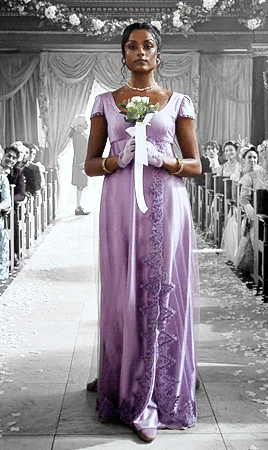
#bridgerton#kate sharma#period costume#indian queens#19th century attire#indian queens in western attire#regency#victorians#costume history#indo western#colonial indian history
79 notes
·
View notes